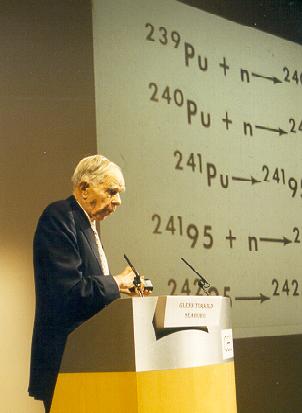A class of very heavy radioactive nuclei
Alongside the fission products found in the core of nuclear reactors there are elements known as actinides, heavy nuclei that also contribute to the radioactivity of the spent fuel. These transuranic nuclei, heavier than uranium, are produced by neutron captures which do not lead to nuclear fission. Their name comes from the element actinium (Z=89), a heavy metal which narrowly precedes uranium in Mendeleev’s periodic table. By the way, uranium itself, which can be found in nature as well as artificially produced, belongs to this family.

Glenn Seaborg
Glenn Seaborg (1912-1999), the physicist who discovered plutonium and several other transuranic chemicals, was so far the only researcher to have lived to see an element named in his honour: seaborgium. Glenn Seaborg received the Nobel Prize for Chemistry in 1951. In the above image, he is giving a lecture at a conference in the Université d’Orsay, on the set of neutron captures required to create the transuranic elements, also known as actinides. Seaborgium is far beyond the heavier natural element, uranium, on the nuclei map. With 106 protons, it contains 14 more than uranium.
© H.Metivier
Plutonium is by far the most commonly produced actinide, with plutonium 239 being its most abundant isotope. Nuclear reactors also generate other, minor actinides in smaller quantities: such as neptunium 238, americium 241 and 243 as well as curium 244 and 245.
The quantities of minor actinides produced may look insignificant when compared with the amount of fission products or plutonium brought into existence. The spent fuel released by a large pressurised water reactor (with a power output of 1.3 gigawatts) every year contains on average: 33 tons of uranium enriched to 0.9%, 360 kg of plutonium, 1.2 tons of fission products and 27 kg of minor actinides. Statistics show that among these 27 kilograms there will be 14 kg of neptunium, 12 kg of americium and 1 kg of curium.
At the time when the fuel is retrieved from the reactor, the activity of plutonium and minor actinides is tiny by comparison with that of the fission products. In that case, why bother dealing with it ? The first reason is that the actinides have much longer half-lives than most fission products, which poses a problem for the long-term storage of radioactive waste. The second reason is that heavy nuclei can also emit alpha rays, which, if absorbed into the body, is more dangerous than the beta rays emitted by fission products.
Nevertheless, this potential radiotoxicity is not a direct danger. Like arsenic, plutonium and minor actinides must enter our stomachs or our lungs in order to become damaging. Fortunately for us, these elements are both too heavy to remains in the air and are often found in the form of insoluble oxides which are not mobile.
After approximately 200 years, the activity and potential toxicity of minor actinides in radioactive waste will be greater than that of the fast-decaying (in comparison) fission products. This is why the clearing up of radioactive waste involves handling plutonium and minor actinides in order to leave a cleaner environment to future generations. With spent fuel reprocessing, plutonium that is separated can be burned in future fast reactors. Minor actinides are effectively neutralized for thousands of years by encasing them in glass or ceramic before burying them in deep underground.
It is possible to go one step further, and either to make actinides disappear by transmuting them into other elements. Another approach is to avoid to let them form in reactors. Thorium-based nuclear reactors have the advantage of no actinide nor plutonium production, a property which makes them appealing.
Other articles on the subject « Nuclear Fission »
200 millions electronvolts !
A huge amount of energy at the atomic scale The fission of a uranium or plutonium nucleus liberat[...]
Chain Reaction
From one single fission to fissions on a massive scale Nuclear fission emits a lot of energy on t[...]
Fissile nuclei
Uranium 235 and 233, plutonium 239 The few fissile nuclei found in nature belong to heavy atoms, [...]
Fission fragment
Chronicle of the life of a fission fragment … The fission of a nucleus into two fragments i[...]
Fission products
The ashes of nuclear fission Fission products are the remains of a heavy uranium or plutonium nuc[...]
Plutonium-239 formation
Transforming a fertile nucleus into a fissile nucleus Uranium-238 accounts for more than 95% of t[...]
Short-lived Fission Products
Most fission products vanish rather rapidly The vast majority of the radioactive fission products[...]
Long-lived Fission Products
A handful of tough but little radioactive isotopes … The more a nucleus is long-lived, the [...]
Plutonium Isotopes
Plutonium-239 but also 238, 240, 241, 242 … Plutonium isotopes are produced by neutron capt[...]
Minor Actinides
Neptunium, americium and curium Minor actinides constitute a very small minority of high activity[...]